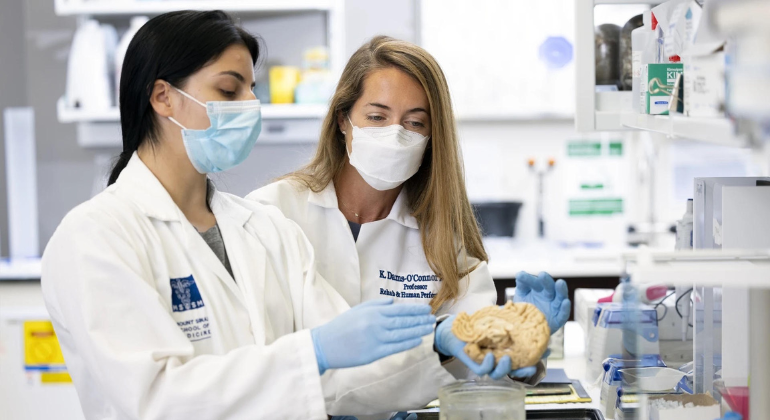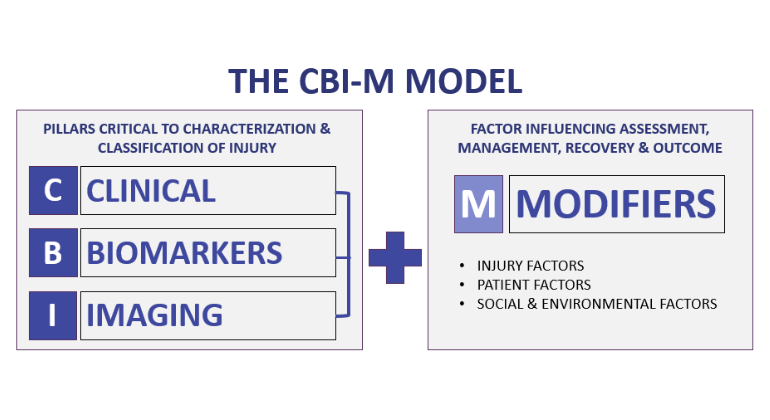Mount Sinai Study Finds Chronic Traumatic Encephalopathy (CTE) Rare Among Individuals With Isolated Brain Injuries

Left to right: Enna Selmanovic, PhD candidate and Kristen Dams-O’Connor, PhD, Director of Brain Injury Research Center at Mount Sinai. Credit: Mount Sinai Health System
Chronic traumatic encephalopathy (CTE) is more common in people who experience extensive repetitive head impacts, and infrequent among individuals with isolated brain injuries or less extensive impacts, researchers from the Brain Injury Research Center of Mount Sinai have found.
The study, published October 18 in the Journal of Neuropathology & Experimental Neurology, adds to knowledge of CTE, which has received extensive media attention amidst limited research in representative samples.
CTE is characterized by a neurodegenerative pathology involving abnormal accumulations of tau protein in the brain associated with head trauma, primarily identified in deceased people who sustained extensive exposure to repetitive head impacts while playing contact sports—especially American-style football. CTE has been reported more rarely in individuals who sustained repetitive head impacts through head-banging, military service, or intimate partner violence.
“Because most prior CTE studies have been conducted in selected samples of male American football players, we know little about the frequency of the disease in individuals with different types of head trauma exposure,” says Kristen Dams-O’Connor, PhD, Director of the Brain Injury Research Center at Mount Sinai and senior author of the paper. “Our study underscores that CTE is rare among individuals with lower amounts of repetitive head impact and in those with isolated traumatic brain injuries, and highlights why community-based research—beyond brain donation from select populations such as professional athletes—is crucial. It’s also important to be clear that we don’t yet know how CTE identified in the brain after death relates to clinical signs and symptoms during life—and we can’t limit our studies to highly symptomatic donors if we want to figure this out.”
Important nuances and differences between terms like traumatic brain injury, repetitive head impact, and CTE are often simplified and/or lost in translation among the popular consumer press and general public, which had led to confusion, fear, and worry among people who have experienced various brain traumas. To address this confusion, the research team provided the following definitions:
- Traumatic brain injury (TBI): a blow to the head resulting in loss or alteration of consciousness, acute signs such as imbalance, or characteristic symptoms such as nausea or vision changes
- Blow to the head: an isolated injury to the head that does not meet the diagnostic criteria for TBI
- Repetitive head impacts: a series of impacts to the head sustained in close succession over time that may or may not result in acute TBI symptoms
- Extensive repetitive head impacts: five or more years of exposure to repetitive head impacts
The Mount Sinai research team analyzed the postmortem brain tissue of 47 donors from the Late Effects of Traumatic Brain Injury Project between 2018 and 2024. The Project is a prospective study of more than 500 people living with TBI who participate in clinical assessments and neuroimaging during life, as well as people whose brains are donated to research after death.
The researchers characterized comprehensive lifetime trauma histories from medical records, autopsy reports, and structured interviews with families. Brains were examined using exhaustive neuropathologic methods, including tau immunohistochemistry. In most cases, postmortem MRI scanning was also used to detect subtle lesions and guide tissue sampling. Diagnosis for CTE followed established consensus criteria.
Among the 47 decedents, seven showed autopsy-confirmed CTE. Six of these donors had lifetime histories of extensive repetitive head impacts while one case had a history of two severe isolated TBIs without known repetitive head impacts. Postmortem neuroimaging further guided detailed histologic sampling in 39 cases, revealing microstructural and vascular injury patterns—subtle long-term changes that may help explain why CTE develops in some individuals but not others.
“As one of the first systematic autopsy investigations of CTE in a cohort of donors with varied types of head trauma histories, this study adds to our understanding of how common or rare CTE really is,” said Enna Selmanovic, PhD candidate at the Icahn School of Medicine and first author of the paper. “While the findings continue to suggest that CTE can be linked to extensive, repeated head impacts, they also underscore the need to better understand how distinct types of head trauma relate to CTE risk, as well as the need to identify additional risk and protective factors. Continued work in diverse populations is essential to move the conversation beyond assumption and towards evidence.”
About the Mount Sinai Health System
Mount Sinai Health System is one of the largest academic medical systems in the New York metro area, with 48,000 employees working across seven hospitals, more than 400 outpatient practices, more than 600 research and clinical labs, a school of nursing, and a leading school of medicine and graduate education. Mount Sinai advances health for all people, everywhere, by taking on the most complex health care challenges of our time—discovering and applying new scientific learning and knowledge; developing safer, more effective treatments; educating the next generation of medical leaders and innovators; and supporting local communities by delivering high-quality care to all who need it.
Through the integration of its hospitals, labs, and schools, Mount Sinai offers comprehensive health care solutions from birth through geriatrics, leveraging innovative approaches such as artificial intelligence and informatics while keeping patients’ medical and emotional needs at the center of all treatment. The Health System includes approximately 9,000 primary and specialty care physicians and 10 free-standing joint-venture centers throughout the five boroughs of New York City, Westchester, Long Island, and Florida. Hospitals within the System are consistently ranked by Newsweek’s® “The World’s Best Smart Hospitals, Best in State Hospitals, World Best Hospitals and Best Specialty Hospitals” and by U.S. News & World Report's® “Best Hospitals” and “Best Children’s Hospitals.” The Mount Sinai Hospital is on the U.S. News & World Report® “Best Hospitals” Honor Roll for 2025-2026.
For more information, visit https://www.mountsinai.org or find Mount Sinai on Facebook, Instagram, LinkedIn, X, and YouTube.


